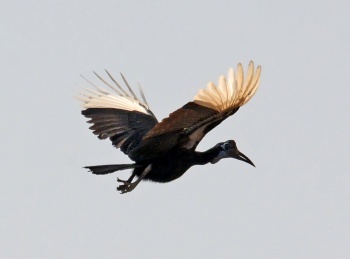Alternative name: Northern Ground Hornbill
- Bucorvus abyssinicus
Identification
Length 90-100 cm (35½-39½ in)
- Black overall plumage
- Large bill with an open-fronted Casque on top
- Blue circum-orbital skin
- Blue area at the front of the throat
- Stubby legs and toes and broad feet
Males develop red on the inflatable throat pouch; the females usually remain all blue.
Flight
- White primaries visible in flight
Distribution
Africa. Thinly distributed south of the Sahara and north of the equator.
Western Africa: Mauritania, Senegambia, Senegal, The Gambia, Guinea-Bissau, Guinea, Mali, Sierra Leone, Ivory Coast, Burkina Faso, Ghana, Togo, Benin, Nigeria, Niger, Chad, Cameroon, Central African Republic, Equatorial Guinea, Democratic Republic of Congo
Eastern Africa: Sudan, Eritrea, Ethiopia, Somalia, Kenya, Uganda
Taxonomy
This is a monotypic species[1].
Habitat
Savanna and grassland.
Behaviour
They are normally seen alone or in small family groups, walking in a somewhat stately manner across the landscape.
Although they are primarily seen on the ground they are capable of flight when disturbed.
Diet
The diet consists of a wide variety of small vertebrates and invertebrates, including tortoises, lizards, spiders, beetles, and caterpillars; also feed on carrion, some fruits, seeds, and groundnuts.
References
- Clements, J. F., T. S. Schulenberg, M. J. Iliff, D. Roberson, T. A. Fredericks, B. L. Sullivan, and C. L. Wood. 2017. The eBird/Clements checklist of birds of the world: v2017, with updates to August 2017. Downloaded from http://www.birds.cornell.edu/clementschecklist/download/
- Avibase
- Handbook of the Birds of the World Alive (retrieved Apr 2018)
Recommended Citation
- BirdForum Opus contributors. (2025) Abyssinian Ground Hornbill. In: BirdForum, the forum for wild birds and birding. Retrieved 1 May 2025 from https://www.birdforum.net/opus/Abyssinian_Ground_Hornbill
External Links
GSearch checked for 2020 platform.






